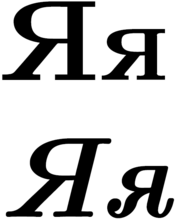Letter (alphabet)
A letter is an element of a writing system. Writing systems include alphabets, abjads, abugidas and syllabaries. As components of writing systems, letters are associated with symbols — also called signs, characters, glyphs and letterforms. A broader term than "letter" is grapheme; it is used for the "atomic units of writing", which include other marks in addition to letters such as punctuation and numerals.
Overview and usage
As symbols that denote segmental speech, letters are associated with phonetics. In a purely phonemic alphabet, a single phoneme is denoted by a single letter, but in history and practice letters often denote more than one phoneme. A pair of letters designating a single phoneme is called a digraph. Examples of digraphs in English include ch, sh and th. A phoneme can also be represented by three letters, called a trigraph. An example is the combination "sch" in German.
Letters also have specific names associated with them. These names may differ with language, dialect and history. Z, for example, is usually called zed in all English-speaking countries except the U.S., where it is named zee.
Letters, as elements of alphabets and other writing systems, have prescribed orders. This may generally be known as "alphabetical order" though collation is the science devoted to the complex task of ordering and sorting of letters and words in different languages. In Spanish, for instance, ñ is a separate letter than n requiring n to precede ñ in alphabetical sorting. In English, n and ñ are sorted alike.
Letters may also have numerical value. This is true of Roman numerals and the letters of other writing systems. In English, Arabic numerals are typically used instead of letters.
History
The use of letters dates back to the Bronze Age in ancient Egypt where 23 hieroglyphs were used to represent individual sounds in the Egyptian language. These glyphs were in use as early as 2700 BC.
The first true use of letters originated with the Semitic alphabet, which appeared in Egypt around 2000 BC. This system of writing eventually evolved into the Proto-Canaanite alphabet, which used only consonants in an abjad system. Virtually all alphabets have their origins from this letter system. The first use of vowels in a writing system was seen in the Greek alphabet, which first arose in the 9th century BC.
Types of letters
The following alphabets and individual letters are discussed in related articles:
Cyrillic alphabet: А, Б, В, Г, Ґ, Д, Е, Є, Ж, З, И, І, Ї, Й, К, Л, М, Н, О, П, Р, С, Т, У, Ф, Х, Ц, Ч, Ш, Щ, Ю, Я, Ь, Ђ, Љ, Њ, Ћ, Џ
Greek alphabet: Α, Β, Γ, Δ, Ε, Ζ, Η, Θ, Ι, Κ, Λ, Μ, Ν, Ξ, Ο, Π, Ρ, Σ, Τ, Υ, Φ, Χ, Ψ, Ω.
Hebrew alphabet: א, ב, ג, ד, ה, ו, ז, ח, ט, י, כ, ל, מ, נ, ס, ע, פ, צ, ק, ר, ש, ת.
Latin alphabet: A, B, C, D, E, F, G, H, I, J, K, L, M, N, O, P, Q, R, S, T, U, V, W, X, Y, Z.
For other writing systems and their letters, see List of writing systems and List of alphabets.
Attribution
- Some content on this page may previously have appeared on Wikipedia.
Footnotes
- Daniels, Peter T., and William Bright, eds. 1996. The World's Writing Systems. ISBN 0-19-507-993-0.
